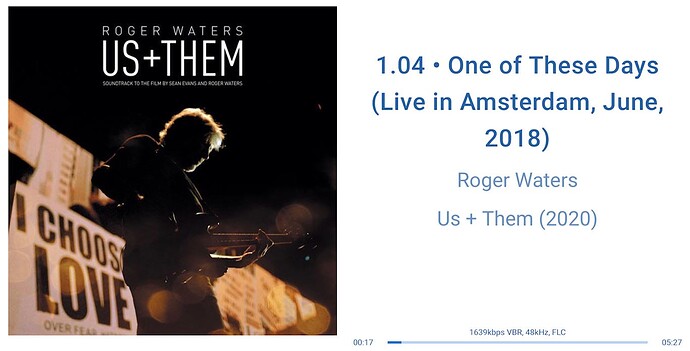Sorry for the delay getting back. Very interesting, and thank you for the details.
To answer your questions specifically: I was using a modded-transformer PS Audio DirectStream for this; and have played around with upsampling on the Mola Mola Tambaqui. Technically I do not have the computing power with the CX to do EC modulators at 256: I use ECv2 for 128, or lesser modulators for 256. What I hear is more complicated, based on my system, room, repertoire, and taste, see below.
As I have mentioned maybe here but more likely on the head-fi Antipodes group, I have played with PGGB and strangely it made little difference – not no difference, by any means, but not clearly better or worse. Both of my DACs at the time were designed around very-high-rate DSD upsampling and we all sort of decided this was why. (PS Audio DirectStream and a Mola Mola Tambaqui)
re: DSD: if I read you correctly you hear a generalized softness with DSD material. I know what you’re talking about. One of the main reasons I have been using it lately is that I listen to a lot of early digital recordings of large choral / baroque orchestral works through studio monitors, and that early digital glare can be particularly unbearable with these recordings of this repertoire. For me, upsampling redbook to DSD128/256 restores a believable roundness of tone, adds space, and eliminates some of the edges that have me lunging for the volume control occasionally with bit-perfect redbook playback. At the same time, I tended to prefer studio music with the benefit of DSD’s ever-so-slightly richer harmonic balance as well. I played with PCM upsampling little because it seemed to make less of a difference.
That was my previous answer. As it happens I picked up a Chord TT2 a few days ago for travel, and happened upon one with an SBooster LPS. I had tried the TT2 w/ stock PSU in my system some time ago, and been impressed but ultimately found it a bit forward for me in my system (see music taste above).
This time, with the LPS, I loved the TT2 + LPS, and provisionally prefer it to my partially-modded DirectStream. By way of consistency, the last time I listened to the TT2 my digital front-end was not where it is now either. (see below)
So naturally I fired up HQP for the TT2 (USB input fed from the Phoenix). With Sinc-S (I can’t run Sinc-M until I build an i9-based machine) or poly sinc gauss and upsampling to 705/768, all the good things about PCM playback that the tt2 does natively are enhanced: a sense of precision, detail, and a remarkable sense of the timing cues of real instruments in space (I’m primarily listening to acoustic recordings as per below). With DSD upsampling (ASDM7EC at DSD128, which is all the TT2 will take) this precise and airy presentation was shifted toward a larger, harmonically fuller and more robust experience.
So this really comes down to taste, and what you listen to. I listen to (oh, sorry, once upon a time I did) a lot of live music in the genres I listen to at home, and have a good sense of what modern and period orchestral instruments sound like. I’m not afraid to say I’m perhaps armchair-remastering early digital recordings, but for me the enjoyment of the end result is a lot more important than a perhaps misplaced sense of reverence for the perfection of the original recording. There is no such reverence for audiophile fetishes in the production of most of the music we listen to, and certainly early digital was a long way off, whatever they might have been doing right with mic placement.
To refine my point a little: for close-miked studio recordings, snap and micro-edged attacks from instruments (which I get from PCM) make sense. This is a constructed sound experience based on acoustic or electronic instruments in a studio. For orchestral recordings in large, airy venues, this ear-next-to-the-soundboard presentation doesn’t work well. Hearing fingerboard shifts in a concert hall is impossible, and would be weird. (yes, solo instruments in a concert hall are a bit different, but I’d argue still closer to orchestra in a hall than to solo instrument in a studio.) And as such (in my system) I imagine I will use PCM upsampling for some recordings (typically electronic and studio) and DSD for others (typically acoustic in a hall). One of may favourite things about HQP (after months of frustration with its non-UI) is the ability to customize things by recording. It’s much cheaper than swapping tubes and cables.
Anyway, now that I have in the tt2 a PCM-oriented DAC I shall have to play with PGGB again. But given that I will be able to resample in realtime with HQP anyway do I need to batch pre-process all my tracks? I’ll admit I considered the possibility once upon a time.
What does PGGB do to your DSD? I’m very curious.
Oh and what is the rest of your system? My Focals are really ruthless on the top end. I feel like I would care less about early redbook if I would just buy speakers with a soft dome tweeter.
EtherRegen 1 / Antipodes CX > Optical ethernet > EtherRegen 2 / Uptone LPS > AQ Vodka Ethernet > Antipodes EX > Curious USB > Innuos Phoenix > Curious USB > Antipodes > AQ Firebird HDMI > PS Audio Directstream (upgraded transformers) > AQ Wind XLR > PS Audio BHK preamp > AQ Water 8m XLR > Focal SM9 active monitors
dedicated 10-gauge 20-amp lines per speaker, and 2 more for source components. PS Audio P5 for digital / network components.


